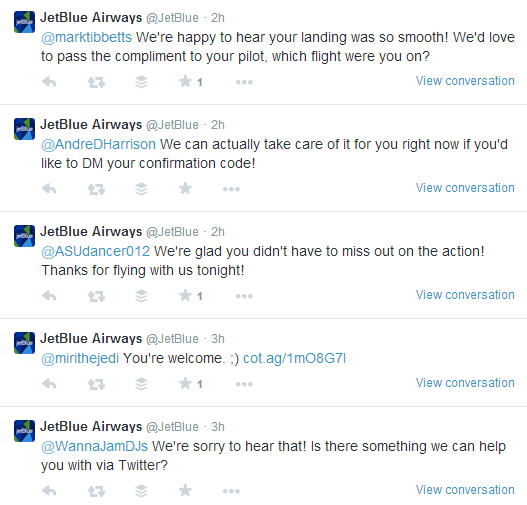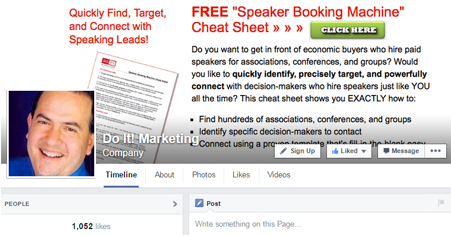How to Boost Your Social Engagement (Even if You Have No Idea What You’re Doing!)
You hear it all the time: “Write engaging posts! Engage with your audience! Engage, engage, engage!” But, even if you are writing well thought-out, carefully crafted content, you still might not be getting the shares and discussions you’d hoped for.
Today’s post aims to change that.
The best part is, you don’t have to be a social hawk, a media maven or a software geek to get the kind of results that you want from your social media endeavors. You just have to follow three simple steps.
I’ll outline them for you, in more detail, further down in this post, but boosting engagement on any social network comes down to three main things:
- Know What Your Audience Wants
- Follow the 5/3/2 Rule
- Scale Your Efforts
Let’s look at the first step — “know what your audience wants”. That’s a pretty tall order to fill. Fortunately, I’ll be breaking down each point into manageable, actionable steps, so that you can start getting social media traction, right away.
Download this cheat sheet: actionable steps to boost your social engagement.
But first, let’s take a look at just what we’re working with:
A Little Background…
There were over 2 BILLION social media accounts, as of January 2015:
- 1.4 of those billion are Facebook users
- Direct uploads of videos to Facebook now exceed direct user uploads on YouTube.

Facebook now exceeds YouTube, as the platform where most videos are viewed, according to OurSocialTimes
- 88% of Twitter users are on their mobile devices
- 88% of Pinterest users ultimately buy a product they’ve pinned
- Instagram grew by 50% between March and December 2014 and now outranks Twitter, with over 300 million users
- Tumblr’s active user base grew 120% in the last six months of 2014 (compared to Facebook’s paltry 2%)

Tumblr grew 120% in 6 months, according to OurSocialTimes
By understanding where your target audience is likely to hang out, you can, in turn, adjust your strategy to focus on them through a platform that they recognize and use every day.
Despite the marked differences of the people who use these social networks, engagement nevertheless follows a few core principles that are the same, no matter who they are:
Know What Your Audience Wants
Your audience, whether they’re recent college grads on LinkedIn or fashion-forward women on Pinterest, has three foundational desires:
- They want to be acknowledged and valued
- They want to connect with like-minded people
- They want to be rewarded
So, how can you make these steps a part of your social media success story bestand downloaden icloud?
Let’s go over each one individually and look at strategies and tools that you can use to implement these concepts in your social media campaigns:
Your Audience Wants to Be Acknowledged and Valued
Many companies forget the “social” aspect of social media – people simply don’t go there with the objective in mind that they’re going to end up buying something. So, fostering a bit of community outreach and understanding can go a long way toward letting people know how much you really do care about their ideas and suggestions.
@AdidasOriginals, on Twitter, compliments fellow users on their Adidas shoe choices, their accomplishments and even their birthdays. If you’re an athlete, getting a mention from your favorite brand just further reinforces that you made the right choice:

With these types of conversations, it should come as no surprise that Adidas is currently the third most engaged brand on social media, according to the SocialRank Global Brands Index.
It’s great when brands reach out to communicate with their most fervent fans. But, what about when things go wrong? Too often, corporate demands that their social media team bury their collective heads in the sand, until the storm passes over.
But, at least trying to meet and overcome objections, head-on, might prevent a lot of the very real backlash that some brands struggle to deal with on Facebook and Twitter, like this example from an AmericanAir flyer:

Perhaps even worse are the auto-tweets, where the same message is displayed when a certain keyword or phrase comes up. One such incident happened with Progressive Car Insurance, where a man’s sister (a Progressive customer) was killed by an underinsured driver. To avoid paying, the claim goes, Progressive’s legal team tried to side with the underinsured driver (who was later found negligent).
For every mention of the case on Twitter, company spokes-character Flo’s smiling face would appear, with this less-than-heartfelt auto-tweet:

The only thing missing here is the hashtag #sorrynotsorry
Contrast these with more proactive conversations, such as the one below from JetBlue:

Twitter aside, even many company Facebook pages are littered with unanswered customer questions. This is particularly problematic for companies that have scheduled their posts weeks, or even months, in advance. Here’s an example, from Social Media Examiner, profiling makeup company Estee Lauder, using a hashtag created by Creative Makeup Director, Tom Pecheux: #TomsTuesdayTip:

Now, most companies would be content to let the post get its share of likes, shares and comments lieder downloaden youtube legal. They would sit idly by, while it racks up those enviable numbers. But, Tom takes the time to answer follower questions, like this:

How to Make it Happen
Don’t forget the social aspect of social media – give your followers insights, behind-the-scenes looks, edge-of-your-seat announcements (before anyone else gets them) or fun quizzes that they can share with friends.

A behind-the-scenes shot of Downton Abbey on Pinterest
Go where your users are most likely to interact with your brand – for years, Doritos and the Super Bowl have been as close as peanut butter and jelly. Traditionally, Doritos’ Super Bowl ad would direct users to vote on a micro-site. But, once they switched to Facebook, they surpassed almost all of their previous records. Users were able to vote for their favorites, with the top video winning a million dollars and being played during the Super Bowl.
Learn how customers use your product – You may be surprised at their inventiveness and creativity! As profiled in Social Media Examiner, Dunkin Donuts held a contest, encouraging customers to tell a story about how Dunkin Donuts fit into their everyday lives. The catch: since the contest was on Twitter, the story had to be 140 characters or less, nine of those using the hashtag #mydunkin. Users were then asked to appear in commercials featuring their stories and the winners were shared on YouTube and other social networks, prompting another call for entries. What Dunkin Donuts has created here is the kind of customer-centric viral cycle that people actively want to participate in and be a part of.

Dunkin Donuts shared user-crafted coffee stories, submitted through Twitter
Don’t Over-Rely on Tools – As you can see from American Airlines’ and Progressive’s gaffes, relying on traditionally time-saving measures, like auto-tweets, can do more harm than good. Use tools to augment, not replace your social campaigns.
Acknowledging your customers and valuing their feedback, suggestions and posts is just one part of your social strategy Super mario free download for pc german. Engagement truly blooms when people don’t just connect with a company, but also connect with each other. This leads us to the second part:
Your Audience Wants to Connect with Like-Minded People
According to the Center for Marketing Research, a study done last year on why millennials engage with social media gives us some great insights on how this generation is embracing the social sphere. Even if millennials aren’t your target audience, there’s no doubt that their actions seep over into other groups as well:

Note the key differences here. This audience segment wants to support their favorite brands and hear from them, but they also want to share their lifestyle with others (particularly on Pinterest). Discounts and coupons are icing on the cake to these fervent supporters.
So, how can you build a lifestyle around your product – particularly if you’re selling something that doesn’t exactly spring to mind as a “lifestyle brand” (toilet paper comes to mind!)?
Get the Audience Actively Involved
The “Golden Tote” is a monthly subscription service that encourages users to “pick a tote” (for $49 and $149 respectively). The subscriber gets to pick two items, while the rest are surprises. In order to encourage more subscribers, they actively ask their Facebook users what sort of items they should carry next, as in this example, featured on SmallBizTrends:

Asking your target audience makes them feel valued, important and part of the group
Latch Onto an Existing Demographic Without Losing Your Appeal
Toilet paper. It’s something everyone uses and everyone needs. It’s also just about the most unappealing product to talk about on social media…or is it?
Toilet paper brand, Charmin, is changing the way people interact with their product, by reaching out to various audience demographics to stress the importance of, and the uniqueness of its product. For example, some of the biggest supporters of good toilet paper are none other than parents:

Charmin asks parents for user stories that revolve around its brand
But, if Charmin were to focus solely on parents, they’d also alienate other large swaths of their user base, which is why they also look for creative ways to integrate their product beyond potty training – such as in crafts, or even wedding dresses (no kidding!)

Toilet paper wedding dresses made with Charmin
Moms, dads and followers of chic, creative wedding attire can both appreciate the inventiveness and utility of toilet paper – an appreciation that few other brands have formed in their audience’s minds aus mediathek downloaden mac.
How to Make it Happen
- Ask Questions – Involve your audience in more than just everyday quizzes, trivia and contests. Give them a behind the scenes glimpse of your work, encourage questions about the product creation process or have them speculate on your next big launch.Don’t be afraid to show them what goes into the making of your product or service – after all, they want to support you and make your brand a part of their lives.
- Embrace a Demographic – Toilet paper and weddings go together like peanut butter and egg rolls. But, in the Charmin example, they were able to turn an everyday item into something unique and interesting. With a little creativity, could your product appeal to moms? Pet lovers? Foodies? Travel buffs?
- Create a Hashtag – What started out as a daily ritual on Instagram has spilled over into Facebook: that is, turning each day into a showcase. You may have heard of #TBT or ThrowBack Thursday, or even #Caturday (Saturday, with cats).But, no one “owns” a hashtag, so you can co-opt a day of the week for your own product and engage your audience to share their images.A few examples:

Manicure Monday

Tuesday Boozeday
And, speaking of Instagram, a study from SocialBakers discovered that posts and profiles on the visual social network receive 50 times as much interaction and engagement as those same brands see on Twitter – so if you’re still thinking of Instagram as just a photo filter app – think again:

Of course, Instagram, Facebook, Twitter and Pinterest all present incredible opportunities to thank your audience for their loyalty, their suggestions, their feedback and even their complaints. That means that in order to foster even more engagement, you need to remember that:
Your Audience Wants To Be Rewarded
There are lots of ways to reward your audience, other than always dishing out discounts and coupons, in exchange for likes and comments. Consider that your audience can feel just as valued with other things that won’t cost you a dime. This example, from Social Media Examiner, illustrates the point perfectly:
David Newman, from Do It Marketing, uses his personal Facebook page to promote his products to speakers. He changed his cover photo to a quick “cheat sheet,” known as the Speaker Booking Machine:

Now, although the cover photo may get him some traction, it’s also easy to overlook, which is why he provided the freebie, exclusively to his Facebook users, through a post:

All they had to do was comment, if they wanted a copy programm herunterladen. It was a simple one-page checklist, but this post alone led to 550 downloads, 120 tele-seminar sign ups and 33 sold seats to a $777 program.
That’s over $25,000 made, without spending a dime on Facebook ads.
And, it’s a win-win – the audience gets something of value to them for free and the product creator gets more sign ups and sales.
How to Make it Happen
- Giveaway Unannounced Bonuses – There’s nothing more surprising and enticing than a surprise “bonus” for your social media followers. And, it doesn’t have to cost anything (except a little of your time). Whether it’s a one page “cheat sheet,” a checklist or an infographic, these rewarding tidbits are always appreciated by a hungry audience.
- Promote Exclusivity with Facebook Offers – The Facebook Offers program is a great way to encourage fan interactions and engagements in a way that you can easily track and tweak. “Dark Posts” – a type of offer, includes a call-to-action button that allows fans to claim an offer right away.

An example of a “dark post” through Facebook offers
Follow the 5/3/2 Rule
When increasing engagement on social media, the last thing that you want to do is post so much of your own stuff that it looks like you’re blowing your own horn a little too much. People will quickly un-follow businesses that concentrate too much on themselves and their promotions.
That’s why various social media experts have come up with certain ratios to help even out the amount of spotlights on yourself. The numbers differ, but the premise is basically the same. The original rule, the 5/3/2 rule, was created by T.A. McCann, from Gist.com and includes a good mix of your own posts, curated posts and personal updates.
The setup goes that for every 10 posts you make:
- 5 should be posts from others (curated content in your industry)
- 3 should be content from you
- 2 should be personal status updates (people like to see that there’s a human behind the brand!)
Obviously, there are variations on this rule and you don’t have to follow these exact rules when posting every single time wetter.com free. But, a good mix shows that while your page is primarily product or service-driven, you haven’t forgotten the human side of things, nor to acknowledge the work that others have done.
How to Make it Happen
You’ve already read about how to prepare your own engaging content and create the types of posts that people will respond to. But, what about content from others? How can you find it and collect it?
There’s no shortage of content curation tools, but one of my favorites is Trap.it. Trap.It actually gets smarter, the more you use it. It pulls from over 100,000 sources which range from blogs to video feeds to podcasts and journals.

Trap.It uses artificial intelligence and machine learning to curate smarter content
If you don’t need quite the sophistication of an enterprise-level tool, there are plenty of other curation tools out there that integrate with your favorite platforms, as well as letting you save snippets, images and other pieces of content from a variety of sources, including rich media outlets.
But, let’s face it, even with content curation, when you consider all of the social media outlets available and the number of hours in a day, it can seem overwhelming. After all, you’re just one person and social media is an ever-shifting landscape where the rules are often changing and your competitors are always looking for a way to surge ahead.
So what do you do?
Scale Your Efforts
Even though you’re alone in your social media engagement efforts, you can give the appearance of having a powerhouse team of rock stars behind you, without breaking the bank games for free. Here’s how you do it:
Take Advantage of Conferences and Workshops
One of the most important ways to scale up your efforts is to use the momentum from conferences and workshops that are important to your audience. Oftentimes, these events will use hashtags as a way to tie together participants’ tweets and posts under one big event umbrella.
If you have a product, service or other item of interest to industry conference-goers, using the event’s hashtag can help you gain more attention from your target audience, even if you can’t be there in person:

Museum conference hashtags get tweeted by historical areas, an app service and more.
Imagine if you sold a product or service that would be of interest to museum curators, staff or historic coordinators – everything from unique history guides to products made by local artisans could draw attention and focus.
Of course, it should go without saying that you should only use this method when you have something of definite interest to conference attendees and not spamming them with unrelated drivel.
Leverage Key Influencers
There’s no guarantee that a key influencer in your industry will like or share your content – but imagine the magnitude of your reach, if they did? There are a variety of tools to help you find these influencers, most notably Klout and BuzzSumo.
Not only can you use these tools to find the people who are making waves in your industry, but, in the case of BuzzSumo, you can also leverage it to see what type of content is getting shared the most.

BuzzSumo shows which content is trending and who the main influencers are stickermania app zum herunterladen.
Once you learn who they are, it makes sense to follow them on social media – even create a Twitter list of them to help you stay organized. Simply click on Lists > Create List > Enter a name and make it either public or private and then click Save List.
You can then click the Gear icon drop-down menu on a user’s profile to add or remove them to a list. You don’t need to be following them, in order to do this. Take steps beforehand to make yourself memorable to them, such as uploading a profile picture to your social media sites and getting yourself a Gravatar.
Then, simply reach out to them – mention them in a tweet, comment on their latest blog post (or better yet, offer to contribute a post of your own) and generally be helpful.
Remember, key influencers are used to receiving lots and lots of pitches and requests. If you’ve contributed an article to them or mentioned them in some way – let them know about it! Take steps to be helpful to them first, without expecting anything in return.
By demonstrating that you’d like to help, you’ll greatly increase the likelihood that they’ll reciprocate.
As an example, all too often I receive “requests” like these:
- Hey I just wrote a piece on (blah). Would you mind sharing it with your mailing list?
- Hey I mentioned you in my blog. Can you share it on Twitter or Google? Maybe link back?
As much as I’d love to help everyone who asks – I simply can’t and this is the way it is with most influencers in your market kassensystem kostenlosen pc. On the other hand, if you wrote something like:
Hi (influencer)!
I just thought you’d like to know that I profiled you as part of my series on Top Experts Who Do Amazing Things. I really enjoyed your insights on awesomeness, especially when you wrote in your book about over-delivering on rock star service. I was wondering if you had anything you’d like to add to the piece? I’d be over the moon if you even so much as left a comment, but I understand your time is valuable, so no pressure!
If you DO leave a comment though, I’d be glad to send you a link when my follow-up post on How Top Experts Do Their Amazing Things goes live. Not surprisingly, you’ll be featured there as well!
This sample email shows the prospective influencer that:
- You’re familiar with them and their work
- You’re a fan of their work or their insights
- You’d be ecstatic if they interacted with you but they’re under no obligation to
- You’d like to reach out to them again in the future with more details
(Feel free to steal that email template, by the way).
Now that you’re absolutely brimming with social media engagement ideas and suggestions, you’ve got to keep that kind of momentum up in the future – which then begs the question:
Once You Build Up Social Media Engagement, How Do You Maintain It?
Social media engagement goes well beyond regular posts and updates. At some point, very early on, it’s going to be a given that most of your audience is familiar with your product or service. That’s the perfect opportunity to stretch your wings and expand on other ideas related to your business, but not necessarily about your products.
For example, if you’re an online clothing retailer, chances are good that your audience wants to know what trends they should expect for upcoming seasons. If you’re a dog groomer, what other tips, beyond grooming, can people take on their own to keep their pets healthy and happy? What sort of foods should they look for herunterladen musik? What should they avoid?
Even just chatting about (positive) current events can reinforce those positive feelings and associate them with your brand. Take time out to do more than just post: Teach. Explain. Relax and have fun – and don’t forget that social media engagement is just as much about the social as it is the media.
What are some other ways to boost your social engagement?



